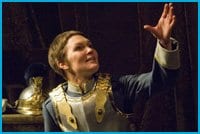Saint Joan is George Bernard Shaw’s take on the well-known story of Joan of Arc — a peasant girl who claimed to hear the voices of saints and angels and led the French army in battle against the English. First produced in New York in 1923, three years after she was canonized by the Catholic Church, this version traces Joan’s story from her first battle through her trial for heresy and her highly unpleasant death being burned alive at the stake. The piece is often considered one of Shaw’s best and helped win him the Nobel Prize for literature in 1925.
The figure of Joan — a girl who dresses like a boy and fights like a soldier — has long been a lesbian archetype and there are numerous references in Shaw’s version that can be interpreted as queer subtext. At various points Joan says that she “might as well have been a man” and “will never take a husband.” When she is tried for heresy against the church, it is not just her claim that she speaks to saints that lands her in the fire, but that she “rebels against nature by wearing men’s clothing.”
The play’s greatest contemporary resonance lies in its discussion of the relationship between church and state. Though Joan herself was a devoted Catholic (some would call her a religious fanatic) it is the Church that brings her to her ultimate demise. The arguments during the play, particularly the climactic trial scene, show a conflict between religious institutions and national powers, not unlike what we see in politics today.
Shaw regular Tara Rosling shines in the lead role with a combination of fiery certitude and teenage innocence. She displays the courage it took for Joan to lead the French into battle, while at the same time, reminding us that Joan was only 17 when she helped the French win the 100 Years War against the English. Rosling is becoming known as one of the finest young actresses in the country and this role is definitely going to up her star power on the national scene.
Norman Browning is wonderful as the Archbishop of Reams, perfectly capturing the stuffiness and immobility of the Catholic Church’s hierarchy. Ben Carlson is a commanding presence as the Bishop of Beauvais. Also notable are Peter Krantz (Chaplain de Stogumber) and Blair Williams (The Earl of Warwick) who provide some delightful comic relief with their discussions of national identity.
Shaw artistic director Jackie Maxwell heads up this production with mostly excellent results. She and designer Sue Lepage have decided to mix costumes from different time periods in an attempt to show the timelessness of the story. Unfortunately, the mixed looks end up being distracting and cheap.
The rest of the design is more successful. LePage’s evocative set and Kevin Lamotte’s beautiful lighting easily transport us between multiple locations while playing on the vastness of the Festival Theatre space. Musical director Paul Sportelli has composed a haunting score that feeds into various moods without being overbearing.
The first act of the production falters slightly because of Shaw’s desire to tell us every detail of Joan’s rise to glory, rather than just concentrating on her fall. At almost three hours, Maxwell could have made some selective cuts to the text that would help it play better. The pace picks up in the second act, however, which is the far more interesting half of the story, and her decision to move the troublesome epilogue to the beginning works well. Maxwell elicits clear and thoughtful performances from the talented ensemble cast and the final moments of the play pack a punch that’s worth waiting for.


 Why you can trust Xtra
Why you can trust Xtra


